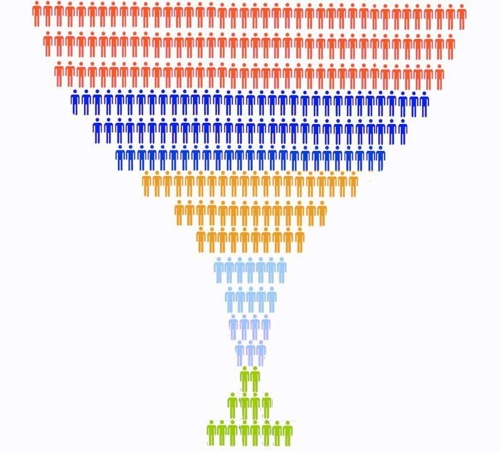The “sales funnel” is a concept used to describe the process of customer acquisition and maintenance, and is likely familiar to you if you’re in the retail or marketing industries. The “funnel” refers to, in effect, the whittling down of your audience to focus on the customers and potential customers with whom engagement will offer the best ROI.
In this post, we’ll take you through the sales funnel with video, explaining each step and demonstrating how video can be used to approach each stage of the customer acquisition process.

Step 1: Awareness
The first step in building your customer base is to identify potential clients on a broad scale, by building awareness of both your product, and the need for your product. Video is useful for promoting your product or brand to many people at once, and when used with social media and promotions, has the benefit of traveling fast (ie. “going viral”).
You can use a video spot to promote your offering in a striking way, for example highlighting features and the problems they solve, and house this within an online contest or giveaway to encourage social sharing. Brands often have success with asking for user-generated content (“Submit a design for our new logo!”) or asking customers to send in video testimonials. These can then be used in later promotions—double win.
In our example, DropBox is featured in a really simple stop-motion video that highlights the main problem it solves – keeping your files in sync wherever you are. While this isn’t a very targeted video, it doesn’t need to be, since it is intended just to generate awareness of a solution to a common problem, and as it has been seen more than a million times, this video has surely helped.
You can also increase visibility of your video by running co-promotions with other brands or companies, using the video as an occasion to show how the products work together. This is a more targeted type of campaign, but allows you tap into an existing segment of viewers who are already interested in another brand or company.
Step 2: Consideration
The second phase is about asking customers to seriously consider your product. You have effectively narrowed the audience down to those who are potentially looking to buy—now you have to convince them they need to.
At this stage, as in the example from Zendesk above, video can be used to give more in-depth information about your product. Video slideshows, animations and infographic tours are excellent ways to visually express the problem and the solution. Client spotlight videos are a way to show how the product solved a real-world problem, and gives a chance to highlight positive testimonials.
Another possibility is a live webcast, especially if your company is holding or attending an event. Broadcast it live to let people in on the action, and to demonstrate the importance of the issue your solution addresses. Make sure you record it so that you can repurpose the footage later on down the road. You never know what kind of moments you might capture.
Step 3: Preference
At this stage, your potential customer has decided that their need is legit, and they need to invest in a product. Now, it’s about convincing them that your product is the superior one, so you need to demonstrate the value of your solution in relation to others.
Video can be used at this point to emphasise your special features through product demos, and comparison videos can be used to show exactly what you have over the competition. You don’t necessarily need to be as aggressive as Suburu in presenting a side-by-side comparison, however, you have to admit it’s a pretty effective tactic! Customer testimonials can also be really useful at this stage, too.
Showcasing the working team is something that is often neglected, and isn’t as effectively done via a website. Video is a chance to speak to the public in a way that shows your team is the one for the job, putting a face to the product, and making you more accessible while showcasing your expertise.
Step 4: Purchase
This is the point at which you close the deal. While the point of purchase is largely determined by the type of product you offer and the format of your storefront (whether it’s online, brick-and-mortar, etc.), video can be used at this stage to lead customers to the purchase (for example, clickable videos that take them to the product page on a website) as well as to take them to the contact point on your website.
For beauty brands like Kat Von D, video is a great sales tool because you can demonstrate a new look or a how-to for specific techniques, showcasing products and generating the urgency to buy in the viewer. Helpful links that popup periodically thoughout the video drive those highly interested viewers to a product page, where they can purchase the products they just saw being applied.
Step 5: Loyalty & Advocacy
The final step, and the one which makes the sales funnel a sustainable cycle, is maintaining your customer base and encouraging referrals via that customer base. In the above video, AirBnB achieved that by involving their current customers in a co-created video project that resulted in a highly shareable piece of content. It’s a nice way of involving those who already have supported their brand, while inspiring those who have yet to take the plunge. Even better, those who participated are even more likely to share it than casual viewers, so a project like this example has built-in advocates to help extend its reach.
Video is a great way to stay on your clients’ radar. For example, a monthly video newsletter or video blog posts that answer frequently asked questions about your product can be great engagement tools. Thank You videos to your loyal customers are also likely to be well-received.
You can encourage referrals to new potential customers via video sharing, especially using social media. The key to this is to make videos that your customers will want to share: give funny or interesting looks “behind the scenes” of your brand, highlight charities or other feel-good topics that your company is invested in, or even put out a blooper video with outtakes from other videos — anything that is entertaining is shareable.
This isn’t a hard and fast set of rules, as video can be used creatively across all of these stages in ways that overlap, but hopefully it sparked some ideas for you to use in your next product campaign.
To get started with your own video promotions, check out what we have to offer at SproutVideo.
Have an idea for using video in the sales funnel? Leave it in comments below or tweet it to us!








